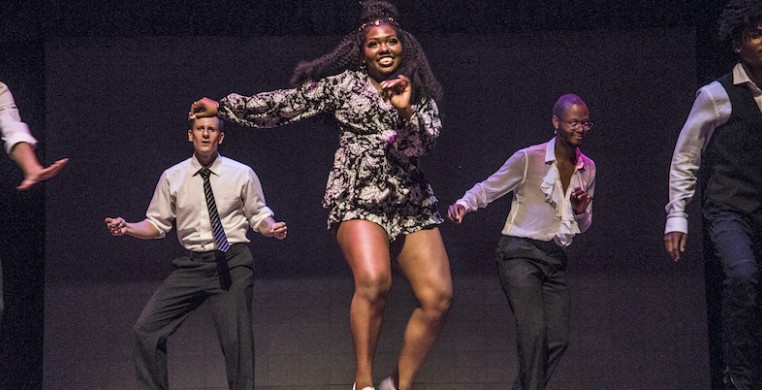Sunday at the Harold Washington Cultural Center, Bril Barrett and his company M.A.D.D. Rhythms performed “Hoofin’ It: The Untold Story of the Founders of Tap,” an extravaganza that included live music, intricate rhythms, spoken word, theater elements, visual media and powerful ensemble work to engage a hybrid audience in the legacy of tap dance. “Hoofin’ It” was presented as the culmination of M.A.D.D. Rhythms’ annual Chicago Tap Summit and Barrett’s 2020 Chicago Dancemakers Forum (CDF) Lab Artist grant award.
The evening began with the 2021 Chicago Tap Summit Showcase, a series of solo and small ensemble performances alongside live musicians Derek Henderson on drums, Charlie Johnson on piano and Dexter Sims on bass. There was an informal and inviting nature to each of the 12 acts, where performers came onstage and either let the band improvise before beginning to dance or gave a quick rhythm with their tap shoes to set the pace before jumping into full-force tapping that blended perfectly with the music. This relationship between musician and dancer became even more apparent when Ja’Bowen Dixon decided on stage at the last minute to ditch his pre-recorded music track to groove with the live band and when Victoria Jones experienced technical difficulties that led her to also work with the band last minute. Both performances radiated joy, into-the-ground grooves and quick and furious footwork that had the audience cheering and clapping throughout their solos. The entire line-up of performers brought something unique and jaw-dropping to their acts. These performers were Ian Berg, Mark Yonally, Megan Davis, Sterling Harris, Case Prime, Ashton Carter, Ari Burns, Jimmy Payne Jr., Abi Roppolo, Jay Fagan, Lisa LaTouche, Miley Melendez, Michael Davis, T’andre Miles, Donetta Jackson, Nico Rubio and the current M.A.D.D. Rhythms company.
After a brief intermission, the formal presentation of “Hoofin’ It: The Untold Story of the Founders of Tap” began. The work cleverly flipped between intimate scenes of Barrett and vocalist and emcee. Ailea Stites; media montages of various tap innovators, legends and moments in history; and large ensemble moments with cohesive, heavy-hitting tap. “Hoofin’ It” has been developing at least since Barrett received an unrestricted grant from CDF in 2020 to pursue this project, which was evident in the deep-level of research, personal narrative and Barrett’s own expertise that acted as the backbone for the work. Star Dixon, Andrew Carr and Donnetta Jackson also contributed choreography to the performance. Whether a seasoned Chicago tapper, a visiting artist or someone with no tap experience, “Hoofin’ It” acted as an engaging lesson and reminder of tap’s history as a U.S. art form developed by enslaved people and Black Americans—and the Chicago artists who actively contributed to what tap is today. In a discussion-turned-friendly-tap-battle between M.A.D.D. Rhythms founders Barrett and Martin “Tre” Dumas, the two listed by name a plethora of need-to-know influential Chicago tappers, including the Whitman Sisters, Sammy Dyer, Tommy Sutton, Jimmy Payne, Sr., Leon Collins, Dr. Jeni LeGon and Skip Cunningham. As a white dancer who grew up studying tap, this was a history that was largely overlooked by my educators. “Hoofin’ It” holds a dual purpose of archiving and celebrating the rich legacy of tap while also providing the beginnings of an honest education (or re-education) of tap’s history for those who need it.
It’s fitting that Ailea Stites played an integral role in the performance. Stites (who uses they/them pronouns) were almost always at Barrett’s side, singing, acting as co-host in a game show skit and providing spoken word context to Barrett’s tapping. One of the most powerful moments of the performance was Stites onstage alone. They sat in a chair, slowly removing their “show woman’s hat,” velvet jacket and makeup—at once removing the smiling facade that they had presented for most of the performance, and signifying the duality of tap as an artform that is joyous, celebratory and loud while also at times a mask for the minstrel-izing of Black artists. As a leader in this performance, Stites acted as an additional reminder of all the overlooked artists who contributed to the creation and development of tap dance. “Hoofin’ It” wasn’t just about Barrett or Barrett’s tap lineage, but also about Stites, the rest of the M.A.D.D. Rhythms company members and all of the other tap dancers—honored and forgotten—who contributed to the form.
The beauty of telling the story of tap through tap dance itself is that while acknowledging its complicated history and celebrating its impactful legacy, the audience could also enjoy tap for what it is. Tap provides a multi-sensory artistic experience that opens a deeper connection both to music and movement. Performances like Jones’ solo, Star Dixon’s choreographic contribution to “Hoofin’ It” and a footworking quartet between Melendez, Davis, Miles and Jackson emphasized the role the upper body and general love of grooving to music can play in tap dance. The varied, complex and fun rhythms of the entire evening provided relief from the heavy and academic content of “Hoofin’ It,” making the evening entertaining and joyous.


